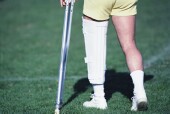
TUESDAY, Feb. 15 (HealthDay News) — Stress fractures linked to overuse may be more common than thought among high school athletes, especially among those who participate in running-related sports, a new study finds.
“The risk is that we’re often dealing with very dedicated athletes who are constantly trying to perfect their performance, and sometimes they overdo it,” said Dr. Letha Y. Griffin, an Atlanta-based team orthopedist at Georgia State University and a staff physician with Peachtree Orthopeadic Clinic. Griffin was not involved with the study.
Stress fractures occur when bones face repetitive strain over a long period of time, especially when bones are not given time to heal.
The new study found that risk factors for stress fractures injuries vary by gender, with young female athletes having a heightened risk for fracture at a younger age and lower body mass than male students.
Still, “our study is suggestive that this is a big problem for all student athletes,” said study author Dr. Andrew D. Goodwillie, chief orthopedic resident with the Robert Wood Johnson Medical School at the University of Medicine and Dentistry of New Jersey in New Brunswick, N.J.
“The fact that we picked up so many stress fractures in such a short amount of time, and that we’re finding that there are clear risk associations to the type of training regimens and dietary habits of the student athletes who are experiencing them, indicates that we’re really just hitting the tip of the iceberg in terms of this issue,” he said.
Goodwillie is slated to present the findings on Tuesday at the annual meeting of the American Academy of Orthopaedic Surgeons in San Diego.
Between 2007 and 2010, Goodwillie and his team tracked the frequency and nature of stress fractures among student athletes enrolled at 57 participating high schools.
At each school, athletic trainers were asked to fill out information forms outlining each young athlete’s sport history, skill level, training intensity, dietary routine and fracture details.
Among the 230 fractures in evidence among 189 athletes (74 boys, 115 girls), the tibia (shinbone) was the most likely to be affected, making up nearly half of all cases. Nearly 20 percent of cases involved the metatarsal bones of the feet, while the fibula (smaller bone behind tibia) was affected in 10 percent of fractures, followed by fractures to the pelvic bone, hind foot and femur (thighbone) .
More than half (53 percent) of the fractures were experienced by varsity athletes, the researchers noted.
Among male athletes, track was the biggest culprit, accounting for more than a quarter of fractures. This was followed by football (23 percent), and cross-country (19 percent).
Among female athletes, track was also the number one source for fractures (28 percent), trailed by cross-country (23 percent).
Gender differences emerged. Boys tended to get injured at a slighter older age than girls, and at a higher body-mass index, the study found. And while boys undertook more intense weight-lifting routines, they also tended to sleep more than their female counterparts, giving bones more time to heal.
“Although there hasn’t been anything out there before that specifically looked at athletes under the age of 18, these findings definitely go along with the adult data we have,” Goodwillie noted. “Basically, the fractures we see are related to running sports like cross-country, track and field, basketball and soccer, in both males and females. You don’t see it in sports such as wrestling and swimming, the non-impact type sports.”
According to Griffin, “the general message here is that fractures can occur with frequency in all high school athletes.”
She believes that “the focus should be on helping kids think about what they need to do to be the best at their sport and perform maximally, rather than by warning them that they might get a stress fracture. Because frankly, young people are never going to think that it’s going to happen to them.”
“So, first I would tell them that if they don’t get enough rest they won’t get the time at night to repair the tissue damage that occurs during the day,” Griffin advised. “And they need to do that to be good at their sport, and also not to be injured.”
“They also need to eat properly,” she added. “You can’t run a car on no gas. Specifically, I would tell them that they need calcium, because they’re building up bone density during the teenage years, up until the age of 25. Drink skim milk if you’re worried about calories. And they need sunshine, so they can get vitamin D [made when sunlight hits the skin] to incorporate into the bones.”
“Basically,” said Griffin, “many of the good things that momma always told you are key, if you really want to be good at your sport and stay healthy.”
More information
For more on stress fractures and high school athletes, visit the American Academy of Orthopaedic Surgeons.

